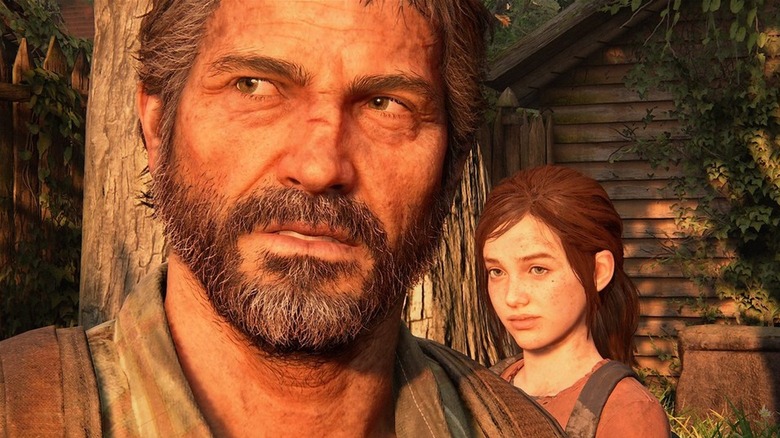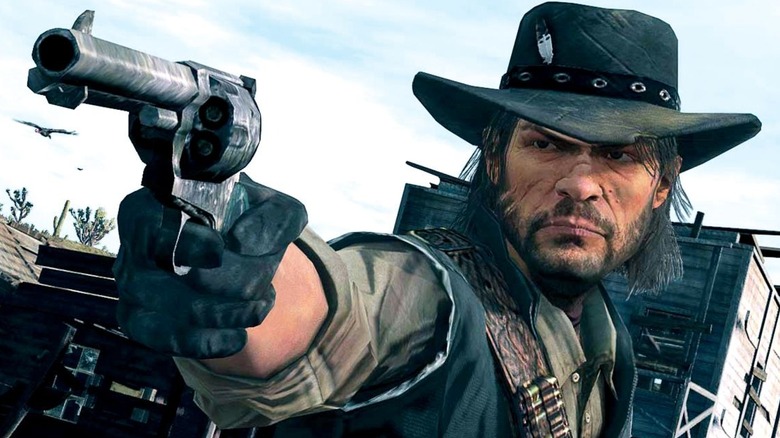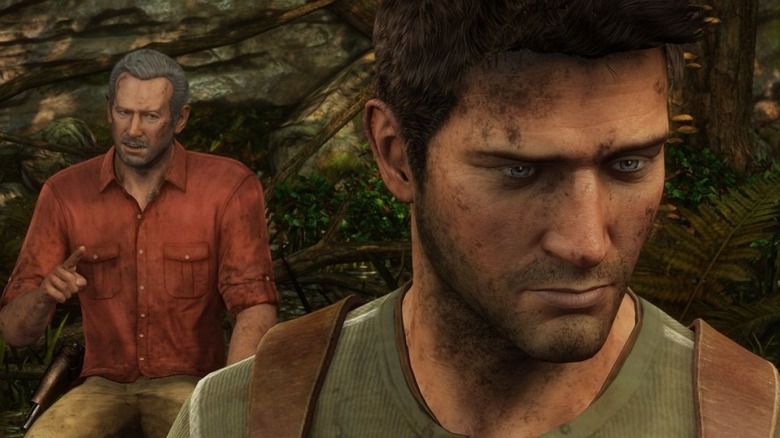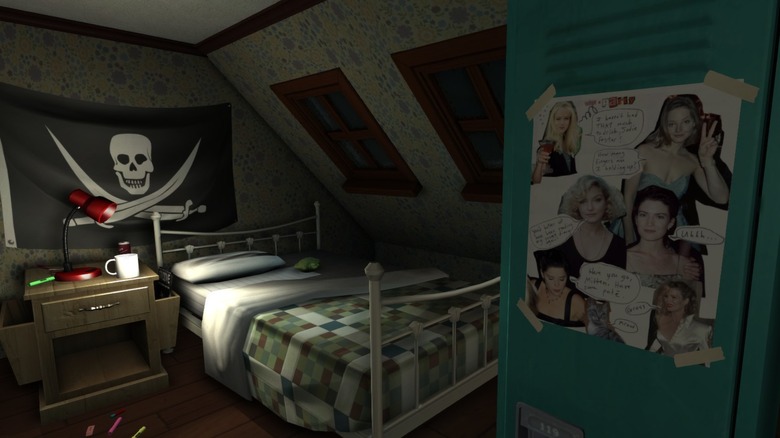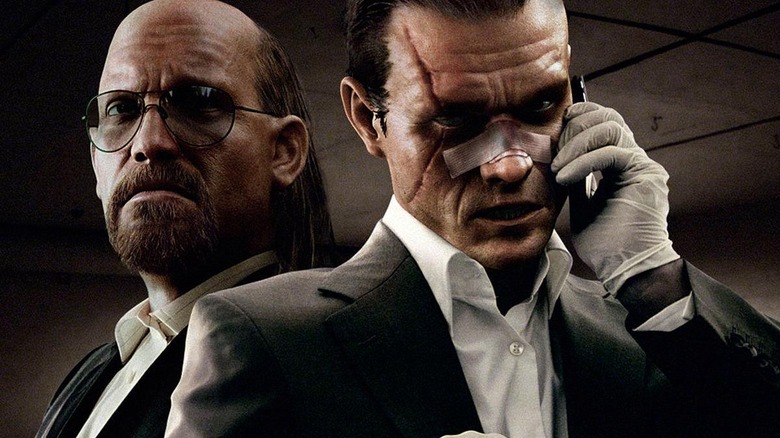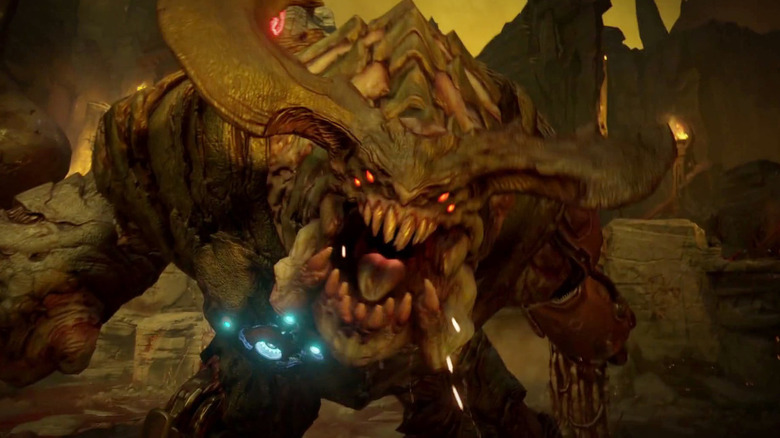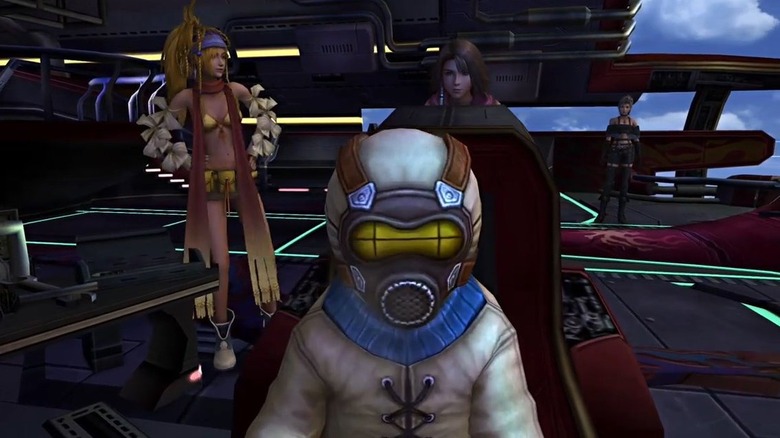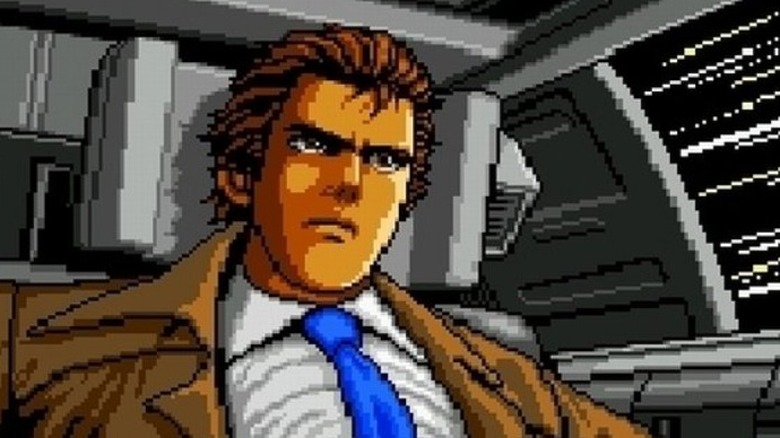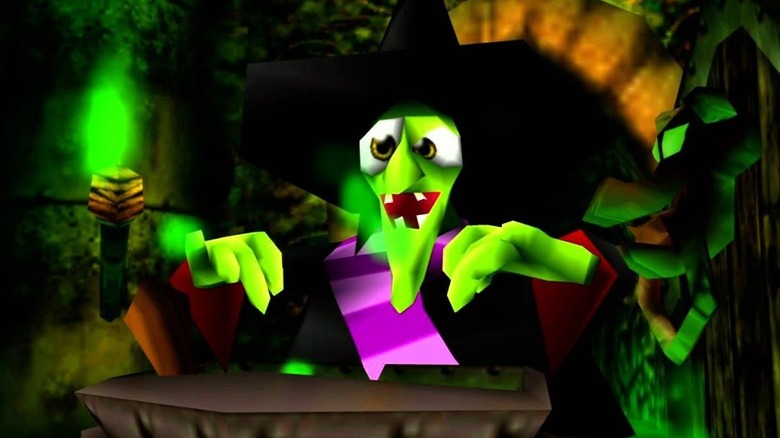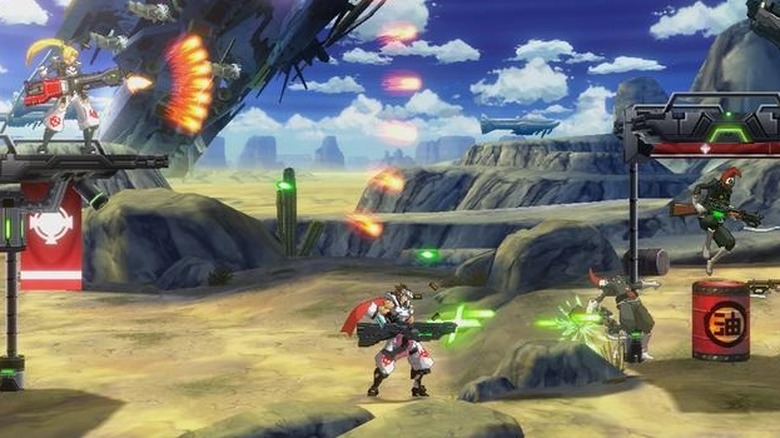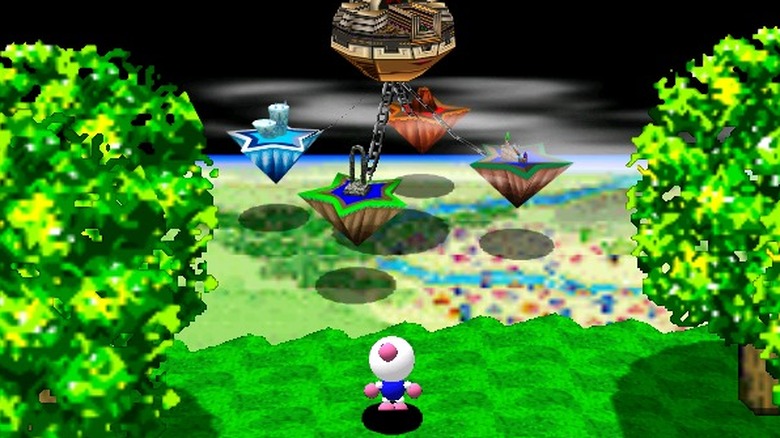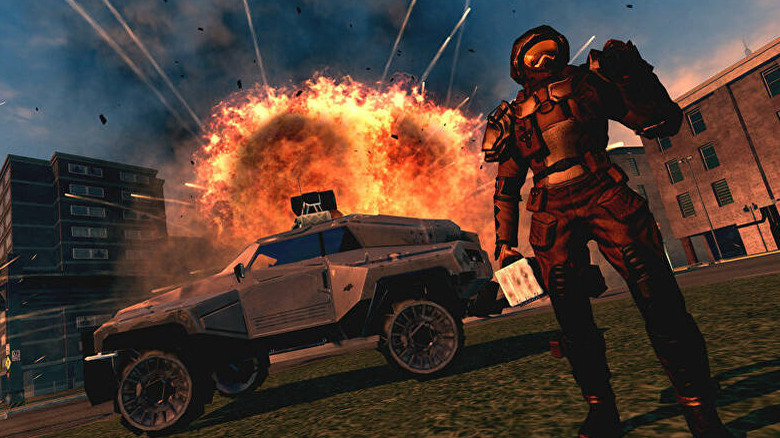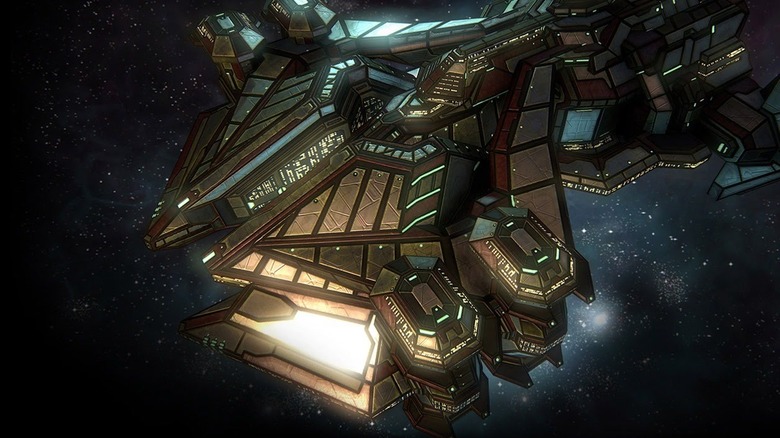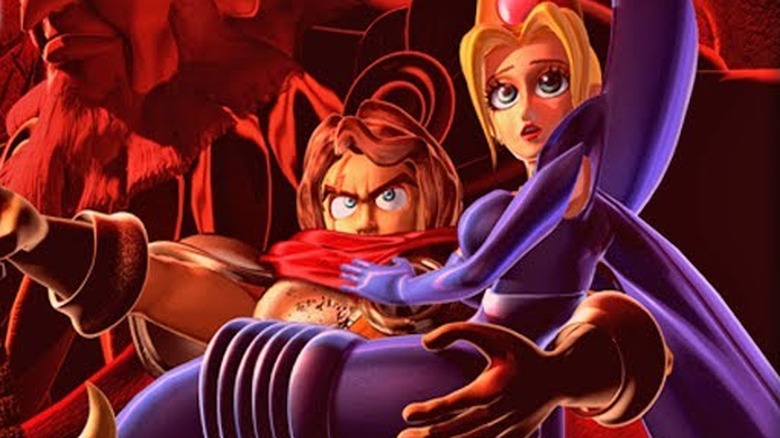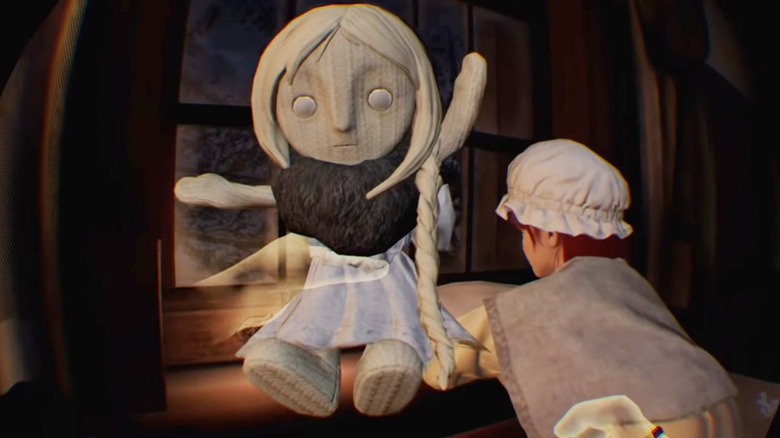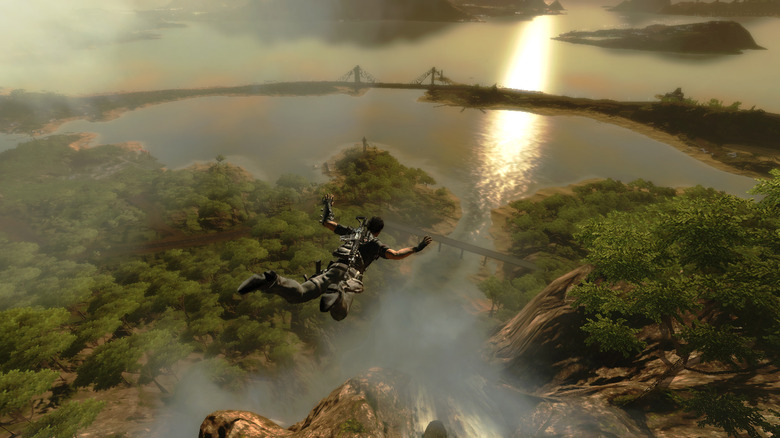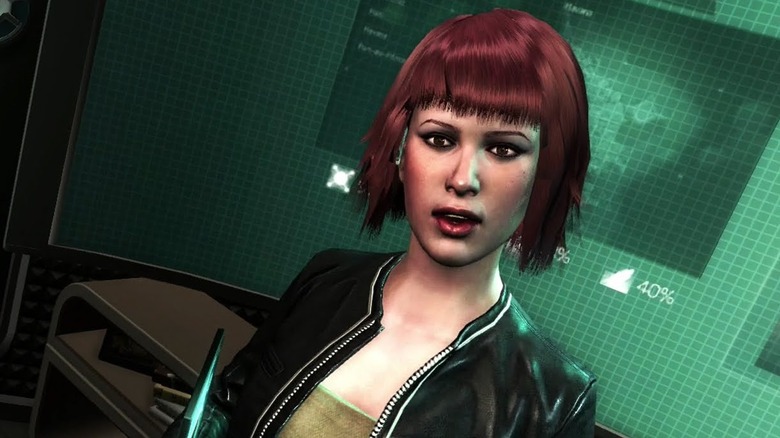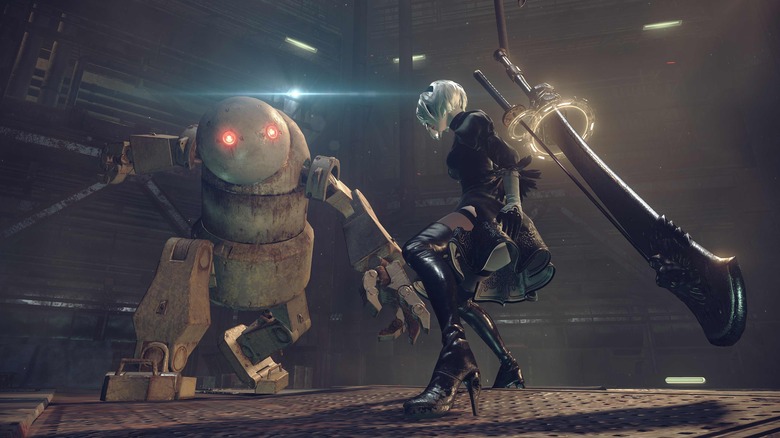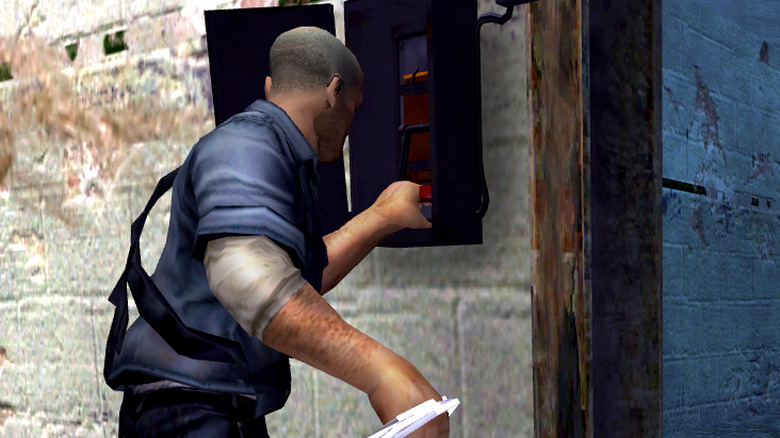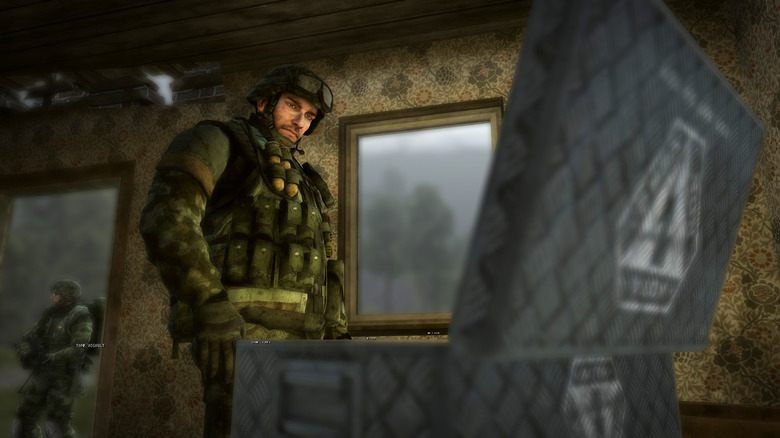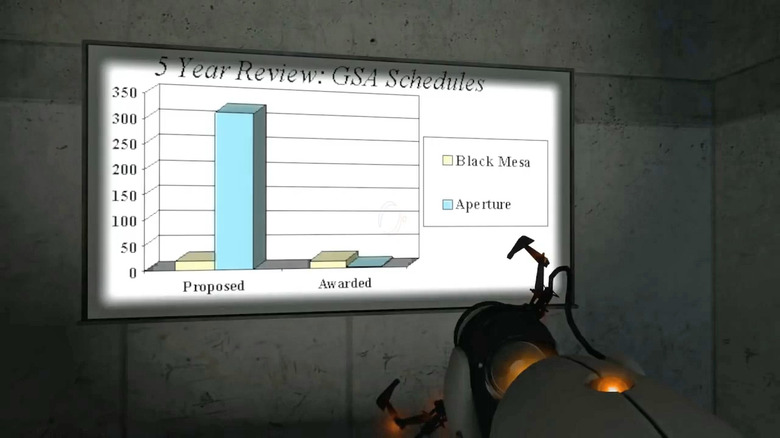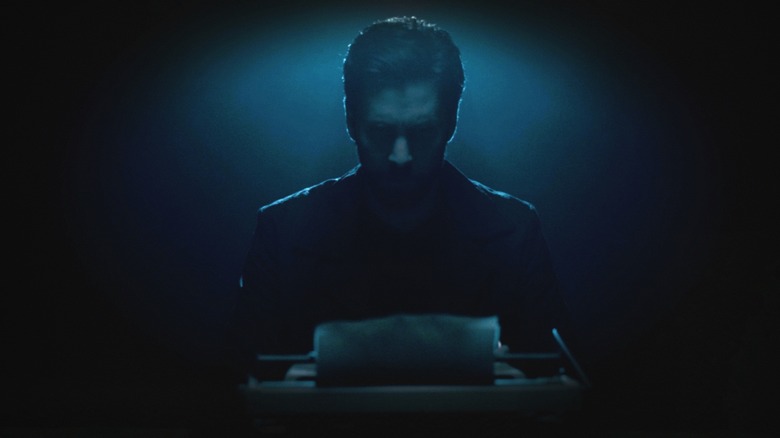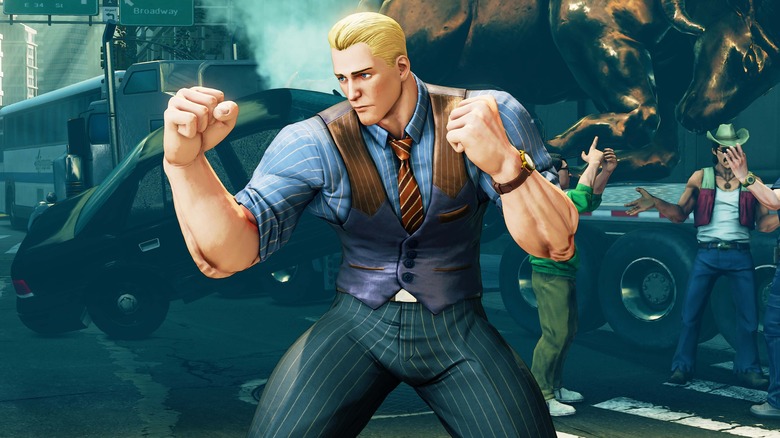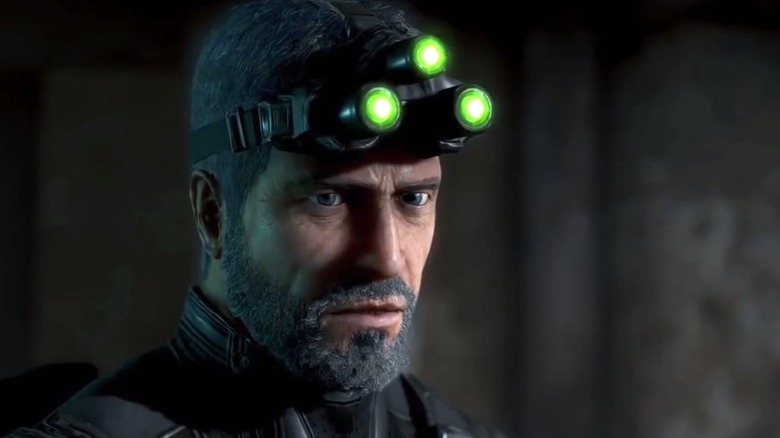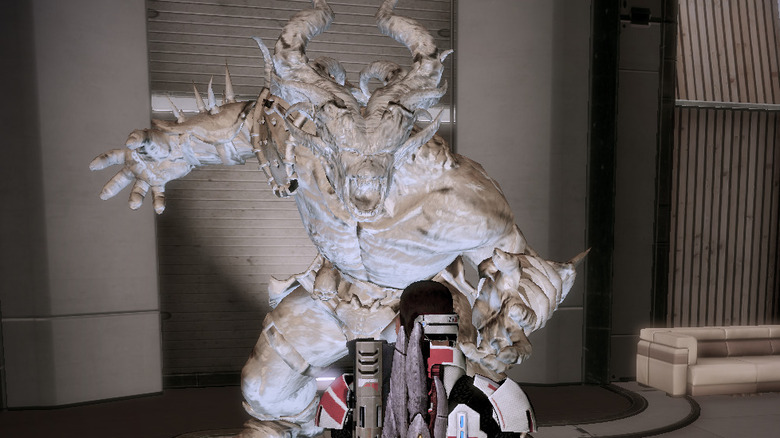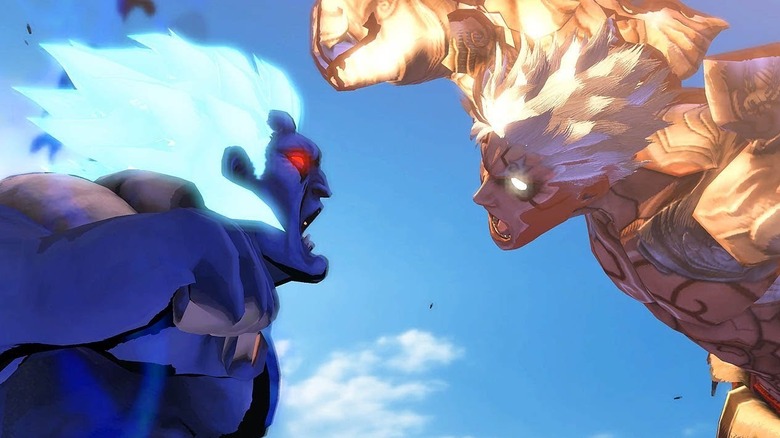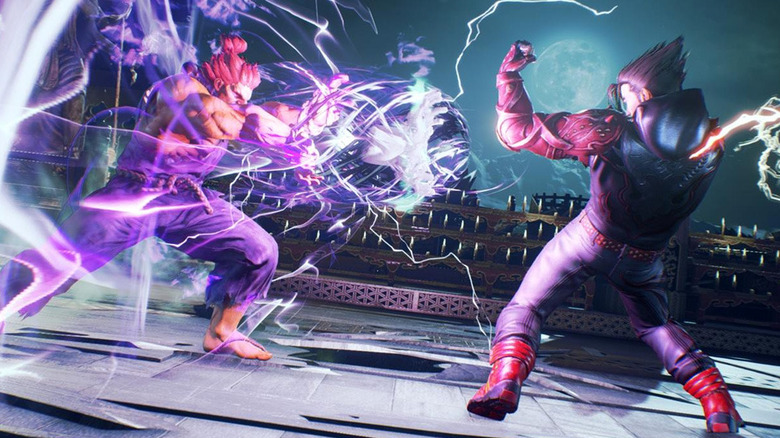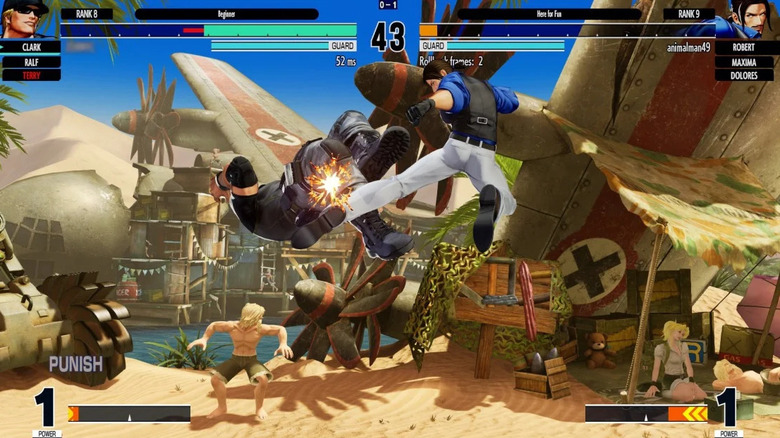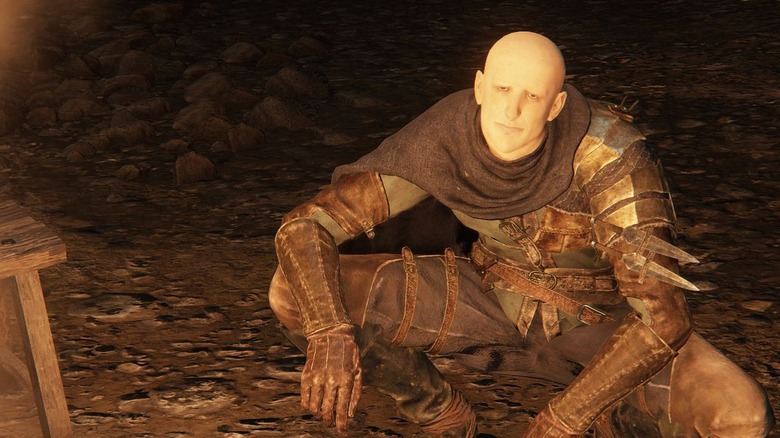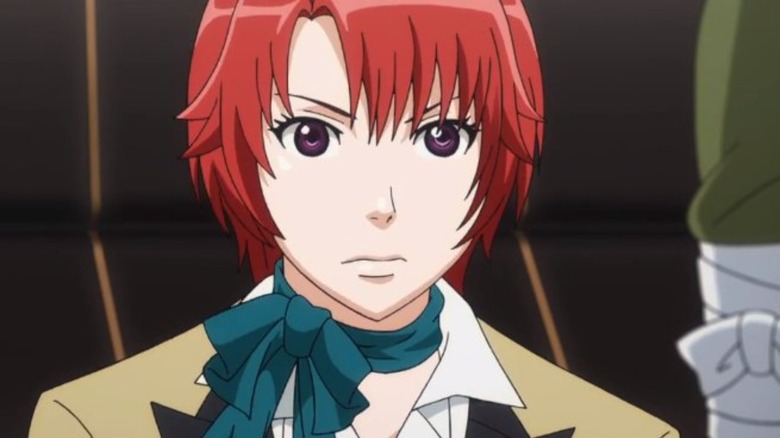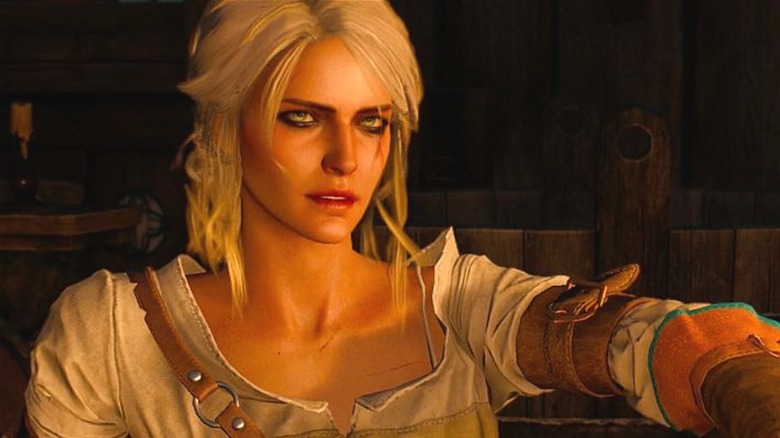Games You Didn't Know Take Place In The Same Universe
Comic book fans have been familiar with shared universes for a long time, but video games are less commonly thought of as places with cosmos in common. You may be surprised to learn that plenty of developers and publishers have sneakily hidden clues that prove otherwise. Sometimes, the relationships between realms end up making a lot of sense. Other times, not so much. Let's take a closer look at some video game universes with startling connections.
Red Dead Redemption heads west to LA Noire
Rockstar Games' Western action-adventure "Red Dead Redemption" takes place in 1911. Rockstar Games' neo-noir action-adventure "LA Noire" takes place 36 years later — and you can bet your bottom dollar they share a universe. During the murder case titled "The Silk Stocking Murder," careful detecting uncovers what appears to be a remnant from the dying days of Rockstar's old west — John Marston's iconic hat. How it got from New Austin to the city of angels is a mystery not even Cole Phelps can unravel, but the details of the hat are unmistakable.
But that's not the only apparent connection. Just as seeing Jesus in toast is a normal occurrence in our universe, seeing a Marston on toast is far from uncommon in Rockstar's Los Angeles. The breakfast miracle can be found twice in "The Black Caesar" case's first crime scene.
Naughty Dog's amazing universe
The "Uncharted" and "The Last of Us" series are two of PlayStation's biggest and best first-party exclusives. But did you know that one is actually (kind of) a sequel to the other?
In "Uncharted 3," there's a newspaper with a headline reading: "Scientists are still struggling to understand deadly fungus" — an intentional reference to "The Last of Us." At the time of the release of "Uncharted 3," however, "The Last of Us" had yet to be formally announced, and that newspaper wasn't actually supposed to remain in the game. "We just completely forgot about it," Naughty Dog's Neil Druckmann candidly told Kotaku. "We screwed up." Fortunately for them, they ended up getting away with it without spoiling their then-upcoming announcement. Most fans apparently assumed it was an Easter egg for an upcoming Guerilla Games or Sony Santa Monica project.
Gone Home has a game from the BioShock universe
While discussing shared universes with Blendo Games co-founder Brendon Chung (via IGN), The Fullbright Company co-founder Steve Gaynor explained how "Gone Home" and "BioShock 2: Minerva's Den" actually take place in the same universe. In the DLC for "BioShock 2," you can find and play a fictional, vector graphics "Asteroids"-esque title called "Spitfire." Some 50 years later in "Gone Home," you can uncover various faux Super Nintendo cartridges in Sam's room. One such cartridge is a fictional Star Fox clone called "Super Spitfire." Far from just a coincidence, closer inspection of the cart also reveals the name of the game's publisher, CMP Interactive, which actually stands for "Minerva's Den" protagonist Charles Milton Porter.
According to Gaynor, Porter probably started the company when he got back to the surface before eventually licensing the "Spitfire" IP to a different Japanese company, who made a new game out of it. Gaynor also mentioned some other connections. "The airline that Katie takes to go to Europe, we never named the airline," he said, "but their logo is an '80s brand update to the airline that Jack's plane crashes into Rapture." Would you kindly accept this shared universe?
The assassin universe of Hitman and Kane & Lynch
Although it's not the most far-fetched connection, given that both series take place in a real-world setting, it's exciting to know that the "Hitman" and "Kane & Lynch" series share the same violent universe. First off, in "Hitman: Blood Money", Kane and Lynch appear in the game's newspapers twice. Referencing the events of "Kane & Lynch: Dead Men," the newspaper reports on the dangerous duo's escape from prison transportation, and later reports that the police are calling it quits on the manhunt.
The titular duo of Kane & Lynch actually make a personal appearance in "Hitman: Absolution" — and, if you want, you can even kill them both. Kane can be found chilling at the trucker and biker bar, while Lynch is popping caps at the shooting range.
The many worlds of id Software
The Blazkowicz family has quite the storied history of violence. It all starts with "Wolfenstein" protagonist William J. Blazkowicz, who eventually settles down with Julia Marie Peterson. The pair have a son named Arthur Kenneth Blazkowicz. On the road to growing up and becoming a television personality, Arthur changes his surname to "Blaze." Arthur Blaze marries Susan Elizabeth McMichaels, and the two gift their son with his grandfather's name, William Joseph Blazkowicz II. Going by "Billy Blaze," the young helmet-sporting Blazkowicz stars in "Commander Keen."
The Blazkowicz line is also repeatedly haunted by one particularly nasty demon. First appearing in "Wolfenstein RPG" as the Axis army-summoned Harbinger of Doom, the big baddie gets his right arm and left leg maimed by B.J. the badass. Upon his defeat, the Harbinger of Doom vows to torment B.J.'s descendants — and he keeps his word. He shows up in various "Doom" titles as the formidable "Cyberdemon," hobbling on one robotic leg and swinging one robotic arm. Therefore, it's safe to assume that "Doomguy" is actually himself a Blazkowicz, thus tying together all three of id Software's famous familial franchises.
Final Fantasy VII and Final Fantasy X/X-2 share more than just the name
The theory that "Final Fantasy VII" and "Final Fantasy X/X-2" share the same universe doesn't sit well with everyone, but there's certainly enough evidence to make a case for it. On the surface, these two games couldn't appear more different. The world of "Final Fantasy VII" is largely dominated by the Shinra Electric Power Company, which uses the planet's own life force — The Lifestream — to create an energy source called Mako. The world of "Final Fantasy X"...well...isn't.
However, near the end of "FF X-2," players can activate a cutscene by talking to an Al Bhed boy, who claims to be researching the planet's life force, which he hopes to someday harness and fuel cities with. And guess what the Al Bhed boy's name is? That's right — Shinra. While it's true that many "Final Fantasy" games contain cameos from previous chapters, this particular instance stands out from the crowd like a Jumbo Cactuar in a blitzball arena.
We're all living in Hideo Kojima's universe
Japanese video game designer Hideo Kojima likes to fill his games with Easter eggs. And that's why his graphic adventure game "Policenauts" offers plenty of clues that it shares a universe with "Snatcher" and "Metal Gear Solid." "Policenauts" has tons of "Snatcher" references. In addition to a few direct cameos from the cyberpunk adventure game, there's a "Snatcher" calendar in Jun Ishida's office, and Victor Jurgens uses the same brand of sunscreen found in both games. There's also a "Snatcher" target in the police station's shooting range that plays a remixed version of the game's "Pressure of Tension" track when it's hit.
In "Metal Gear Solid," you can find two promotional posters for "Policenauts" in the Nuclear Warhead Storage Building, with a third popping up in "Metal Gear Solid 2: Sons of Liberty." Drebin 893 drinks a soda called Narc, which is named after the addictive drug in "Policenauts," and there's even a bar named after Solid Snake in the Old L.A. of "Policenauts." And that's just scratching the surface of the cosmic clues — happy hunting!
The Rare universe of big mammals
Though we rarely see them together, the characters from Rare's "Donkey Kong Country," "Banjo-Kazooie," and "Conker" franchises all inhabit the same universe. For instance, in the sinister game show "Grunty's Furnace Fun" from "Banjo-Kazooie," host Gruntilda provides "Cranky Kong" as a wrong answer to one of her questions, thus proving her knowledge of the character. Furthermore, in "Banjo-Tooie," Bottles' daughter, Goggles, can be seen playing with a Donkey Kong toy.
Cementing the three franchises' shared universe is "Diddy Kong Racing," in which the titular character recruits the help of both Banjo the bear and Conker the squirrel to defeat an evil intergalactic wizard pig — appropriately named Wizpig. Unlike the "Super Smash Bros." series, which features Nintendo's superstar lineup of characters duking it out as toys, "Diddy Kong Racing" explicitly implies that Conker, Banjo and the Kongs not only share the same universe, but actually live in fairly close proximity to one another.
A universe of pure bullet hell
First released on Xbox Live Arcade on Feb. 16, 2011, "Hard Corps: Uprising" is a Konami-published run-and-gun video game developed by Arc System Works that feels a lot like "Contra." Because it is. You may not have realized that "Hard Corps: Uprising" is actually the 13th installment in the "Contra" series and takes place 20 years before the events of the original "Contra." Though there's not a lot to officially tie the games together, the binding link comes in the form of Bahamut, the primary antagonist from "Contra: Hard Corps," who also appears — at least in name — in "Hard Corps: Uprising."
"The game is really inspired by 'Contra: Hard Corps,'" producer Kenji Yamamoto told Siliconera in 2010. "Many 'Contra' fans realize 'Contra: Hard Corps' is a little bit far from the regular 'Contra' franchise. Since we're going to link it to 'Contra: Hard Corps' we could make this into a brand new franchise."
Bomberman and Lode Runner form a very early crossover universe
Although you wouldn't know it from any of their recent installments, "Lode Runner" and "Bomberman" actually stem from the same universe. In fact, Lode Runner is Bomberman. The proof comes in the original version of "Bomberman" on the Nintendo Famicom. According to the English manual for the NES version, Bomberman is basically a robotic slave in a bomb-manufacturing factory. One day, he catches wind of a rumor that any robot who escapes to the surface can become human and decides to take his chances against the factory's defense forces. "Will he ever make it up to the surface," the manual asks, and "once there, will he really become human?"
Spoiler alert! He does, but he doesn't become just any human. He becomes the Lode Runner himself, as explicitly witnessed in the ending of the Famicom version. Therefore, the original "Bomberman" is technically the prequel to the original "Lode Runner," which itself features a whole slew of "Bomberman" sprites. Since then, the two series have gone their separate ways, but they'll forever be linked by a long-forgotten metamorphosis.
Red Faction is the future of the Saints Row universe
The "Red Faction" series from Volition and THQ tells the story of the titular faction's resistance against the oppressive reign of the nefarious Ultor Corporation, set amidst a sci-fi future of dystopian proportions. Meanwhile, the "Saints Row" series from Volition and THQ (along with latter day publisher Deep Silver) chronicles the story of the Third Street Saints, a street gang turned global crime organization who face rival criminals and corrupt law enforcement during their ongoing slapstick quest for domination. As luck (and the cheeky developers of Volition) would have it, the events of the "Red Faction" series actually take place in the future of the "Saints Row" universe, and the nefarious Ultor Corporation is the link.
In case you missed it, the episodic expansion packs "Ultor Exposed" and "Corporate Warfare" for "Saints Row 2" are probably the most overt references to "Red Faction's" big bad adversaries in the "Saints" series. The first of these two DLC packs lays the groundwork for exposing the megacorp's seedy operations, while the second installment offers players a chance "to put a permanent end to Ultor's corruption" head on. The result: one of the wildest canonical crossovers in video game history.
Galactic Civilizations was the secret origin of the Elemental universe
At first glance, "Galactic Civilizations" and "Elemental: Fallen Enchantress" from Stardock Entertainment have little more in common than their genre and creator. "Galactic Civilizations" is a turn-based strategy title from 2003 that tells the story of humanity's future amidst galactic conflict with alien lifeforms, while 2012's "Elemental: Fallen Enchantress" (another turn-based strategy offering) chronicles the tale of a world of high magic contested by powerful factions. But astute fans might very well discover the ties that bind these two disparate titles and the distinct (yet mysterious) lineage their worlds share.
According to the official "Galactic Civilization" databanks, people of the spiritually inclined Altarian civilization look nearly identical to humans. Indeed, "DNA tests showed that they were essentially the same species, with only a few hundred thousand years of genetic drift." "Fallen Enchantress" would reveal the origin/future of these Altarians to be none other than the Elemental kingdom of Altar — ruled by Relias, the bold adventurer who investigated the fearful Eastern prophecies of the Empire of Sorcery. Furthermore, Tandis (the last Arnorian of "Galactic Civilizations" fame) managed to travel through time and space to aid Elemental's great Sorcerers in their historic battle against the Titans.
Ghosts 'n Goblins 'n Gargoyles 'n Demons 'n Maximo
Retro game enthusiasts know all about Capcom's 1985 quarter-munching "Ghosts 'n Goblins," an action-platformer simultaneously cheered and jeered for its notorious difficulty. The sequels are likewise both feared and revered in the annals of game history. But this legendary franchise of medieval fantasy had wings to fly, and two distinct spinoffs in the same universe were the eventual result. "Gargoyle's Quest" for Nintendo's Game Boy was a lesser-known successor of the "Ghosts 'n Goblins" legacy that pushed one of its forerunner's minor enemies — the flame-spewing gargoyle Firebrand — to the forefront as the protagonist of a platformer-sandbox experience. "Gargoyle's Quest 2" and the fan-favorite "Demon's Crest" would eventually follow, but the world-building wouldn't stop there.
Yet another entry in the "Ghosts 'n Goblins" universe, "Maximo: Ghosts to Glory" was Capcom's deliberate attempt to infuse their classic horror setting with the stylish fantasy of artist Susumu Matsushita — resulting in a quite different (yet familiar) take on Sir Arthur & Co.'s ghoulish realms that languishes in obscurity to this very day.
Bloodborne invades the Déraciné universe
Kotaku's Patrick Klepeck declared, "It's uncommon to finish a game and still have so many burning questions about what's left to be discovered, but that's the kind of game 'Bloodborne' is." No doubt, FromSoftware's nightmare-fueled action-RPG is a modern masterpiece of horror storytelling, with a collection of lore that is both staggeringly complex and devilishly simple. A huge portion of that lore emanates from the Hunter's Dream and its caretaker, an animate porcelain doll who guides the player towards their inevitable confrontation with the Old Ones (alien entities of colossal eldritch power that offer mind-bending revelations about the infinite fabric of reality). In fact, the protagonist of "Bloodborne" can "Make Contact" with these cosmic beings using a peculiar ceremonial gesture.
Interestingly enough, a similar doll appears in FromSoftware's mysterious VR experience for PS4 known as "Déraciné". And as fan speculation mounted, FromSoftware found themselves squelching expectations for a "Bloodborne" sequel. Yet, while director Miyazaki & Co. regret the decision to include the Fiona Doll in "Déraciné" — describing its tongue-in-cheek inclusion as "overboard" — the oneiric, elliptical nature of the Lovecraftian narrative in "Bloodborne" and the doll's specific use of the "Make Contact" gesture suggest otherwise.
Sleeping Dogs has a cameo in Just Cause 2
The Malaysia-inpsired island of Panau is the setting of "Just Cause 2," the 2010 open world action-adventure game from Avalanche Studios and Eidos Interactive. It tells the continuing story of chaotic hero Rico Rodriguez and his battle against some of the world's craziest militant dictators. Interestingly enough, Panau also makes a subtle appearance in "Sleeping Dogs," the Hong Kong-based action adventure from United Front Games and Eidos parent publisher Square Enix.
One Easter egg from "Sleeping Dogs" definitively places these two games in the same universe. If your timing and radio station are correct, you'll hear a fun little advertisement that shouts out the familiar setting of "Just Cause 2." It says, "For a relaxing getaway, visit the island of Panau, an exotic location where beauty and luxury are an everyday pleasure. Sunbathe on long, golden beaches, win big at Panau Falls Casino, or enjoy five-star service at Three Kings Hotel. Come to Panau for a holiday you'll never forget."
The massive connected universe of Ubisoft
French video game publisher Ubisoft made its reputation by developing some of the most immersive open world games on the market — games that emphasize exploration and branching narratives over linear storytelling and guided adventures. It's no surprise, then, that Ubisoft would decide to set a few of their fan-favorite franchises in a shared universe; but the clues aren't always up front.
Fortunately for us, the modern-day sequences of "Assassin's Creed 4: Black Flag" offer some clarity. Set in the offices of a video game development studio known as Abstergo Entertainment (a not-so-subtle front for Abstergo Industries, aka the Templar Order, the Assassins' rival faction), these sequences provide several distinct references to Ubisoft's "Watch Dogs" and "Far Cry 3."
For instance, the "Security Systems Presentation" offers a blatant reference to the primary city-wide hacking mechanic of "Watch Dogs": "Nowhere is our expertise more apparent than in our flagship product, 'ctOS' – a ground-breaking proprietary security-software operating system." Meanwhile, the Abstergo Entertainment database entry for "Ocelot" obliquely suggests that "Far Cry 3" (the video game itself) could actually be yet another virtual construct of the Animus (cue the "Blood Dragon" flashbacks).
Who knew that Drakengard and NieR: Automata were the same universe?
The science-fiction stylings of "NieR: Automata" from PlatinumGames and publisher Square Enix seem like a far cry from the medieval fantasy of "Drakengard" from Cavia Inc. and Macrospace Ltd. — but these two action-RPGs are separated by a lengthy span of sequels and studio changeovers, so they actually exist squarely in the same universe.
The description of "NieR: Automata" on the game's official website tells us its story takes place in "the distant future." That future is, in fact, a far-flung time period following the events of "Drakengard," which chronicles the dark fantasy story of the deposed prince Caim and his efforts to stop the malevolent Watchers from destroying the world. Game scholars understand the "E" ending of "Drakengard" — in which Caim and Angelus travel across a dimensional boundary to fight the Queen Grotesquerie — to be the canonical ending that leads into the 2010 hack-and-slash RPG Nier (itself a direct forerunner of "NieR: Automata").
In "NieR: Automata," we learn, "Mankind is driven from Earth and takes refuge on the Moon." Now, with the full history laid out before us, we finally understand that particular Earth to be the alternate-history Earth of "Drakengard," known as Midgard.
The twisted Rockstar universe
With ample evidence of a UFO conspiracy that interlinks the background narratives of "Grand Theft Auto 5" and "Red Dead Redemption 2," it's safe to say that Rockstar Games are no strangers to shared game worlds. But did you know that "Manhunt" from Rockstar North was also set in the "GTA" universe? A variety of evidence suggests that it is: notably, the very location of the game's controversial narrative.
"Manhunt" takes place within the fictional setting of Carcer City, a ruthless lampoon of America's Rust Belt, where street gangs rule the night. GTA fans who paid enough attention will probably recognize Carcer City from one of its many subtle appearances in the series; it's been mentioned at least once in every "Grand Theft Auto" release since "GTA 3," including the "Stories" spinoffs developed for handheld consoles. And if there was any doubt, James Earl Cash — the sociopathic protagonist of "Manhunt" — appears on wanted posters within the "Grand Theft Auto" universe, most notably in locations like the Las Venturas Police Department in "San Andreas." Crime might not pay, but in Rockstar's shared worlds, it'll definitely make you famous.
Mirror's Edge is the next era of the Battlefield universe
With its focus on a single-player campaign, "Battlefield: Bad Company" from DICE was a bit of a departure from the tried and true formula of the fan-favorite FPS franchise in 2008. But the game's humorous narrative, along with its introduction of highly destructible environments, made it a smash hit. GameSpot called it "quite simply one of the most fun shooters released [that] year."
DICE were also responsible for "Mirror's Edge: Catalyst," the 2016 sequel of their unique sci-fi action platformer, also from 2008. Catalyst expanded the story and gameplay of the original and took a few narrative liberties in its effort to round out the lore behind Faith Connors and her death-defying run through The City. DICE looked to their previous titles to establish a "real world" element for the dystopian future of "Mirror's Edge" by placing the boys from "Bad Company" directly into the expanded narrative of "Catalyst." Just take a quick listen to Intel Recording "Omnistat Gold #01" for all the sordid details.
The Valve universe is still alive
Valve Corporation's legendary first-person shooter "Half-Life" changed the video game industry forever when it hit personal computers in 1998. IGN called the original installment of this hallowed franchise "a tour de force in game design, the definitive single player game in a first person shooter." It tells the heart-pounding story of theoretical physicist Gordon Freeman and his dimension-shattering discoveries at the Black Mesa Research Facility. And curiously enough, Black Mesa would prove to be part of the game's connective tissue to another Valve title, "Portal," the award-winning 3D puzzle-platformer released in 2007.
"Portal" takes players on a wild ride through the Aperture Science laboratories as they try to unravel the enigmas of the artificial intelligence known as GLaDOS and learn for themselves that the cake is a lie. Astute gamers will recognize oblique clues in GLaDOS' dialogue that reference the events of "Half-Life," along with a tongue-in-cheek PowerPoint presentation. Furthermore, Aperture founder Cave Johnson mentions his Black Mesa rivals by name during a scene in "Portal 2." Whether or not industrial espionage is healthy for business, it certainly made for one sweet spinoff.
Alan Wake influenced the worlds of Quantum Break and Control
Remedy Entertainment's connected universe is more intricate than many fans realize. Remedy's 2010 game "Alan Wake" is a bizarre trip through alternate dimensions. As the title character searches for his missing wife, he begins to see elements of a story he wrote coming to life. The endings of "Alan Wake" and its follow-ups left its hero's fate unclear, which has tormented fans for years. But did you know references to Mr. Wake have shown up in Remedy's newer titles? "Quantum Break," released in 2016, features several callbacks to "Alan Wake." For instance, a chalkboard in the game seems to describe events from Alan Wake. Not only that, another Easter egg revealed live action footage of Alan Wake himself.
Then came 2019's "Control." Through documents discovered during "Control," players learn that the game's Federal Bureau of Control investigated the events of "Alan Wake," but unfortunately didn't find much. Footage of Alan can also be found in a hidden area of the game. The "AWE" expansion for "Control" brought Bureau Director Jesse Faden into conflict with Emil Hartman, a mad psychologist with ties to Alan and Alice Wake. "Alan Wake 2" made these connections even more explicit with shared characters from "Control."
Street Fighter continues Final Fight's story
While Sega had the "Streets of Rage" franchise, Capcom had "Final Fight" as its own side-scrolling, beat' em up video game series in arcades and on the Super Nintendo. By 1993's "Final Fight 2," Capcom began including nods to its other major franchise, "Street Fighter," as the former series' characters travel beyond their hometown of Metro City to fight crime around the world. In the game's opening level in Hong Kong, Chun-Li can be seen eating noodles in the background, while Guile can be seen later in the level, watching the fight from inside of an airplane hanger.
The connection between "Street Fighter" and "Final Fight" would become more pronounced starting with the "Street Fighter Alpha" trilogy, with "Final Fighter" characters like Guy, Cody, and Rolento being added to the roster. Set after the events of "Final Fight 3," the "Street Fighter Alpha" trilogy revealed Cody became addicted to violence and was imprisoned for his wanton vigilantism. The "Final Fight" characters would continue to be a steady presence in the "Street Fighter" franchise moving forward, with Cody eventually being elected Mayor of Metro City in "Street Fighter 5." What a glow-up!
Dead or Alive expands the world of Ninja Gaiden
One of the bigger fan-favorite video game series on the Nintendo Entertainment System was "Ninja Gaiden," which saw a trilogy of titles on the console that introduced players to master ninja Ryu Hayabusa. Following the release of "Ninja Gaiden III" in 1991, Ryu's next appearance was in the fighting game series "Dead or Alive," which launched in 1996. While the "Dead or Alive" series continued, with Ryu as a staple on its playable roster, the "Ninja Gaiden" franchise was revived for modern audiences in 2004.
"Ninja Gaiden" and "Dead or Alive" share the same continuity, with Ryu entering the fighting tournament on behalf of his ninja clan and playing a major role in the franchise's story while the "Ninja Gaiden" games reference "Dead or Alive". Ayane and Kasumi, two characters introduced in "Dead or Alive" have since taken on supporting roles in the "Ninja Gaiden" revival series, leading to their eventual inclusion as playable characters. Ayane was introduced in the first "Ninja Gaiden" revival series entry as a lethal courier rescued by Ryu, with her half-sister Kasumi joining the two ninjas to help them defend the world from the forces of darkness.
Metal Gear, Splinter Cell, and Syphon Filter share the same stealthy world
While the "Metal Gear" franchise may have pioneered the stealth action genre, it also made passing references to other video game series that helped popularize the genre. 2004's "Metal Gear Solid 3: Snake Eater" had Naked Snake remark to Roy Campbell that either "Sam or Gabe" are just as well-suited to accomplish a monkey-snatching mission as him. The Sam that Snake is referring to is Sam Fisher, the protagonist of the "Splinter Cell" series, while Gabe refers to Gabriel Logan from the "Syphon Filter" series.
Sam Fisher paid back the name-drop to "Metal Gear" in his crossover appearance with the 2017 video game "Tom Clancy's Ghost Recon: Wildlands." As Fisher teams up with the Ghost team in Bolivia, he recalls another prolific old espionage expert that preferred to wear a bandana, alluding directly to Snake. In a reference to Snake retiring at the end of "Metal Gear Solid 4: Guns of the Patriots," Fisher muses that he is the only one of his ilk still active in a surprisingly poignant moment.
Mass Effect hints at a sci-fi location for Dragon Age
Among BioWare's biggest RPG franchises are the sweeping space opera "Mass Effect" and the medieval dark fantasy "Dragon Age," which launched in 2007 and 2009, respectively. And believe it or not, there have been a number of instances in which the two different franchises have intersected. The first overt link between the two games takes place during Kasumi Goto's loyalty mission in "Mass Effect 2," in which a life-sized statue of a "Dragon Age" ogre can be found in a vault. "Dragon Age: Inquisition" would similarly include a trophy-inspired nod to "Mass Effect," with heads of Krogan warrior race mounted on walls around the region of Orlais.
The biggest clue that "Mass Effect" and "Dragon Age" take place in the same universe, however, is at the planet Klendagon and its moon Presrop within the Hawking Eta cluster. The surface markings on Presrop match those seen on Thedas' moon from the "Dragon Age" series. "Dragon Age: Inquisition" also reveals that Thedas has two moons, dispelling any assumption that "Dragon Age" takes place on Earth. Further analysis of Klendagon reveals that the planet was seemingly devastated by a catastrophic event, suggesting an extinction-level event may be coming for the fantastical world of Thedas at some point in the future.
Asura's Wrath gives Street Fighter an ancient history
The 2012 Capcom game "Asura's Wrath" is one that defies conventional gameplay genres, from run-on-rails progression and sections that resemble beat 'em up action, plus fighting that's driven by quick-time events. Set during the prehistoric era, the game features a world in which humans, monsters, and demigods all live together, with the story following Asura as he seeks revenge on the deities who betrayed him. However, the game's epilogue flashes forward to present day and reveals that "Asura's Wrath" is connected to Capcom's long-running "Street Fighter" franchise.
In a facsimile of New York City, Asura and several of the other demigods he encountered in the past brace themselves for a coming meteor, all while "Street Fighter" character Chun-Li keeping the peace as a police officer. "Asura's Wrath" DLC deepens its connection to "Street Fighter," with the latter's Ryu and Akuma being transported to Asura's timeline separately through a strange portal. Each of the wandering warriors challenge Asura to a martial arts showdown, with Ryu being temporarily transformed into Evil Ryu and Akuma taking on the demonic form of Oni.
Tekken 7 creates a fighting game shared universe
While Bandai Namco's "Tekken" fighting game series had included nods and Easter eggs to other video game franchises for some time, the 2017 installment "Tekken 7" took this sense of interconnectivity to a higher level. DLC released for the game included several guest characters to the proceedings, each with their own backstories tying into the larger narrative of "Tekken 7." And while Negan from "The Walking Dead" and Noctis Lucis Caelum from "Final Fantasy 15" do not figure into the story in "Tekken 7," Akuma from "Street Fighter" and Geese Howard from "Fatal Fury" were more organically included.
Akuma enters "Tekken 7" vowing to kill both Heihachi and Kazuya to fulfill an old promise to Kazumi, who showed him mercy when he was gravely injured years ago. Geese is not closely tied to the main "Tekken 7" narrative, but it's implied through his guest appearance that he has his own rivalry with Heihachi, with both men positioned as competing tycoons. With Akuma and Geese being added to "Tekken 7," the foundations of a potential fighting game shared universe between Bandai Namco, Capcom, and SNK may have been established.
Speaking of which...
SNK brings its biggest properties together in a single series
Before "Marvel vs. Capcom" or "Super Smash Bros.," the first notable fighting game crossover was "The King of Fighters '94," which was developed and published by SNK. Initially bringing together the rosters of the games "Fatal Fury," "The Art of Fighting," among others, the crossover series eventually brought in additional SNK properties. And as the "King of Fighters" series has continued, the narratives from the other SNK franchises have become more intrinsically linked to form a full-on shared universe. Even characters from non-fighting games, like the side-scrolling "Ikari Warriors," were able to get in on the action.
By "The King of Fighters 2000," characters from the long-running "Metal Slug" franchise were added to the roster, participating in the international fighting tournament, presumably when they were taking a break from waging high-tech battles around the world. Further bridging the links between the various properties, characters from "The King of Fighters" would also appear in the 2014 mobile game "Metal Slug Defense."
A familiar face appears across the Souls games
Video game developer FromSoftware has created a whole sub-genre of hack-and-slash titles, with evocative dark fantasy settings and an intense level of difficulty. Starting with 2009's "Demon's Souls," FromSoftware proceeded to launch the "Dark Souls," "Bloodborne," and "Elden Ring" franchises. And beyond just sharing gameplay sensibilities and themes, there are hints that all of these properties are more connected than they may appear. One of the biggest of these connections between every "Souls" game arrives in the form of a recurring character who menaces the player in various forms.
Director Hidetaka Miyazaki has included the NPC Patches in most of the games that he has helmed, starting with 2008's "Armored Core: For Answer." This character continued his reign of terror in the "Souls" games, followed by an appearance in a mutated arachnid form in "Bloodborne." Patches also appeared as an (untrustworthy) merchant in "Elden Ring." With "Elden Ring" becoming a tremendous critical and commercial success, gamers probably haven't seen the last of Patches anytime soon.
Dino Crisis characters in Ace Attorney
While a lot of bizarre things happen to Phoenix Wright throughout the "Ace Attorney" series, a crossover with fellow Capcom property "Dino Crisis" was never one of them. However, something like this isn't too far off the table, considering some eagle-eyed fans have discovered that the two franchises take place in the same universe. While there isn't a heaping pile of evidence, fans have found two strong pieces of proof. In "Ace Attorney Investigations: Miles Edgeworth," Edgeworth discovers a murder victim's passport which states they're from the Republic of Borginia. For those that are unfamiliar, this just happens to be the same Republic that houses Ibis Isle, where "Dino Crisis" takes place. Second, the "Ace Attorney" anime features three "Dino Crisis" characters: Regina, Rick, and Gail. Although the latter two characters look quite a bit different from their original designs, and their names have been slightly altered, it seems like an intentional callback to Capcom's defunct franchise.
Although many of these nods could just be considered noncanon easter eggs, many fans are convinced that these references link the "Ace Attorney" and "Dino Crisis" universes together. While "Ace Attorney" still is going strong as a franchise, fans are still hoping to see the return of "Dino Crisis. "Now I want a crossover between Ace Attorney and Dino Crisis taking place in Borginia, with a Dino as a prosecutor" one fan comments.
The Witcher's Ciri predicts Cyberpunk 2077
It might seem farfetched to believe that CD Projekt Red's two most iconic game franchises, "The Witcher" and "Cyberpunk 2077," take place in the same universe, particularly when the genres are so different. However, some fans have noticed a few details that may prove that these two series may at least be in the same multiverse. For example, when traveling to other universes to escape the Wild Hunt, Ciri reveals that she saw a world where the citizens "had metal in their heads and traveled around in flying machines."
Additionally, following the release of next-gen updates for "The Witcher 3," YouTuber xLetalis noticed that a mysterious new easter egg was added to the game: After performing a series of complicated actions and sneaking past some Specters, players can find a mysterious symbol of a magenta triangle with a circuit board pattern running through it. This pattern will look very familiar to gamers, as the design was also seen in "Cyberpunk 2077." It's worth noting that "Cyberpunk 2077" director Adam Badowski told Polygon that he rejects the shared universe theory, even with all the evidence. However, players believe Badowski is just playing coy, and continue to search for more connections hidden in the two games.

